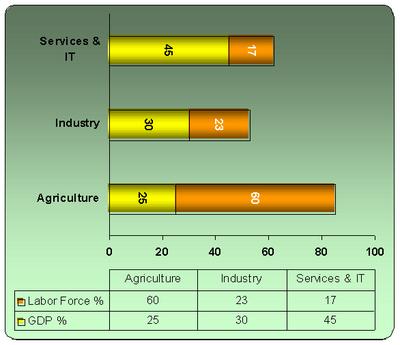India's foreign reserve is around $131 (as of Jan-1, 2005) billion dollars. However, what is disturbing is our GDP and Labor force distribution. 
GDP1 (Gross Domestic Product) Distribution.
- 25% is from Agriculture
- 30% is from Industry (of which 19% is manufacturing)
- 45% is from Services & Information Technology
Labor Force: 470 million
Labor Force Distribution
- 60% Agriculture
- 23% Industry
- 17% Services & Information Technology
Decline in contribution of agriculture towards GDP for the past two decades is in sync with the growth pattern of any developing countries. The share of agriculture in the GDP has shrunk to 25% in 2004 from 40% two decades ago, however the labor force reduction was only 10% i.e., from 70% two decades ago to 60% as of now.
| INDIA | China | USA |
| 2004 | 2020 | 2004 | 2004 |
| GDP | Labor | GDP | Labor | GDP | Labor | GDP | Labor |
Agriculture | 25% | 60% | 10% | 15% | 14.8% | 50% | 1.4% | 2.4% |
Industry | 30% | 23% | 35% | 35% | 52.9% | 22% | 26.2% | 24% |
Services & Others | 45% | 17% | 55% | 55% | 32.3% | 28% | 72.5% | 73% |
Labor Force | 470 Million | 700 Million | 778.1 Million | 146.5 Million |
Public Debt2 | 59.7 % of GDP |
| 30.1 % of GDP | 62.4% of GDP |
Exports | $57 Billion |
| $436 Billion | $714 Billion |
Imports | $74 Billion |
| $397 Billion | $1.26 Trillion |
GDP per Capita3 | $2900.00 |
| $5000.00 | $37,800.00 |
PPP4 | $3.033 Trillion |
| $6.449 Trillion | $10.99 Trillion |
GDP Real Growth Rate5 | 8.3% |
| 9.1% | 3.1% |
The transformation in the GDP is typical of developing country experience. However, if you look at the labor force distribution, we find that 75% of the GDP contribution comes from 40% of the labor force.
All successful developing economies moved significant numbers of people out of agriculture as the share of agriculture in the GDP declined. Looking at the developed nations GDP (see US) shows this fact.
So, over here 60% of (Labor force) our population is dependant on Agriculture and imagine the chaos it will create when there is monsoon failure. Another misconception is that while China has become world’s factory India in the last 10 years becomes the world’s knowledge center – which looks better in paper. China did the right thing in the last 15 years to transform their Agriculture labor force by bringing in industrialization, and that is the natural progress (Agriculture to Industry to Service). Thanks to the liberalization of early 1990’s India did pretty well in the last 15 years. However, we did pretty well in the Service and IT (Information Technology) sectors, neglecting our Agricultural labor force. So, to bring our 60%s Agriculture labor force down to 15% – 20% (i.e., approximately around 220 million people), we need to create more jobs in our industry sector and we need to have good plan and commitment to do the transformation.
We (India) could become an economic giant in 2020 if we were able to move people from Agriculture to other industries. We need government's who could see into the future to do this transformation.
The question over here is –
WHAT CAN WE (The people of India) DO TO HELP THIS TRANSFORMATION?
1. GDP – Gross Domestic Product is the value of all final goods and services produced within a nation in a given year.
2. Public Debt – The cumulative total of all government borrowings less repayments that are denominated in a country's home currency. It should not be confused with external debt, which reflects the foreign currency liabilities of both the private and public sector and must be financed out of foreign exchange earnings.
3. GDP Per Capita - GDP on a purchasing power parity basis divided by population.
4. PPP – Purchasing Power Parity (2004 estimate).
5. GDP Real Growth Rate - GDP growth on an annual basis adjusted for inflation and expressed as a percent.



